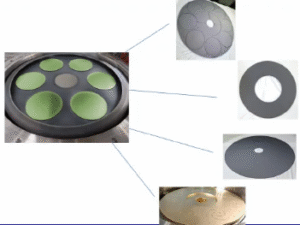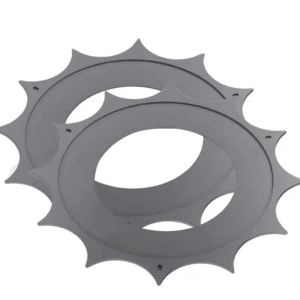Tantalum carbide (TaC) coatings exhibit remarkable superiority over silicon carbides (SiC) in the domain of SiC single crystal growth. Their enhanced thermal resistance, chemical stability, and mechanical strength distinguish them significantly. These coatings substantially improve the quality of crystals, ensuring a more efficient growth process. TaC’s capability to endure extreme conditions without compromising integrity makes it an invaluable asset in this field. The application of TaC coatings not only enhances the structural properties of the crystals but also optimizes the overall efficiency of the growth process, surpassing the benefits of traditional SiC coating.

Key Takeaways
- Tantalum carbide (TaC) coatings significantly enhance the quality of SiC single crystals by providing a stable environment that reduces impurities and structural inconsistencies.
- The superior thermal resistance of TaC allows it to withstand extreme temperatures during the crystal growth process, ensuring the integrity and reliability of the coatings.
- TaC’s remarkable chemical stability prevents unwanted reactions with reactive gases, maintaining the purity of the growing crystals and minimizing defects.
- Using TaC coatings can lead to a 20% increase in material yield, optimizing resource utilization and reducing production costs.
- The mechanical strength of TaC coatings enhances their durability, allowing them to endure the physical stresses encountered during crystal growth, which improves overall efficiency.
- Future innovations in TaC coatings, including advancements in nanotechnology, promise to further improve their properties and effectiveness in SiC single crystal growth.
- Adopting TaC coatings supports sustainable practices in crystal production by reducing waste and enhancing the quality of the final products.
Overview of SiC Single Crystal Growth
The Process of SiC Single Crystal Growth
SiC single crystalSiC single crystal growth involves a meticulous process that requires precision and control. Manufacturers typically employ the physical vapor transport (PVT) method. This technique involves sublimating silicon carbide powder at high temperatures. The vapor then condenses on a cooler seed crystal, forming a single crystal. This process demands a controlled environment to ensure uniformity and quality in the crystal structure. Temperature gradients, pressure conditions, and the purity of the initial materials play crucial roles in determining the success of the growth process.
Role of Coatings in Crystal Growth
Coatings serve a pivotal role in the SiC single crystal growth process. They provide a protective barrier that enhances the quality and efficiency of crystal formation. Tantalum carbide (TaC) coatings, in particular, offer superior thermal resistance and chemical stability compared to traditional SiC coating. These properties allow TaC coatings to withstand the extreme conditions present during crystal growth. By reducing contamination and improving thermal management, coatings contribute significantly to the production of high-quality SiC crystals. The choice of coating material can directly impact the mechanical strength and overall yield of the crystal growth process.
Properties of Tantalum Carbide (TaC)

High Melting Point
Tantalum carbide (TaC) boasts an exceptionally high melting point, reaching approximately 3,880 degrees Celsius. This characteristic makes TaC an ideal candidate for applications involving extreme temperatures. During the SiC single crystal growth process, the environment often reaches intense heat levels. TaC’s ability to maintain structural integrity under such conditions ensures a stable and reliable coating. This property not only enhances the durability of the equipment used but also contributes to the overall efficiency of the crystal growth process.
Chemical Stability
TaC exhibits remarkable chemical stability, resisting reactions with most acids and bases. This inertness proves crucial in the harsh environments encountered during SiC single crystal growth. The presence of reactive gases and high temperatures can lead to unwanted chemical interactions. TaC coatings effectively prevent these reactions, maintaining the purity of the growing crystals. By minimizing contamination risks, TaC ensures the production of high-quality SiC crystals with fewer defects. This stability also extends the lifespan of the equipment, reducing maintenance costs and downtime.
Thermal Conductivity
The thermal conductivity of TaC plays a significant role in its superiority as a coating material. TaC efficiently conducts heat, allowing for better thermal management during the crystal growth process. This property helps in maintaining uniform temperature distribution across the growth chamber, which is vital for producing consistent and high-quality SiC crystals. Improved thermal conductivity also aids in reducing thermal stress on the equipment, further enhancing its longevity. By optimizing heat transfer, TaC coatings contribute to a more controlled and efficient crystal growth environment.
Comparison with Silicon Carbides (SiC)
Thermal Resistance
Tantalum carbide (TaC) coatings exhibit superior thermal resistance compared to silicon carbide (SiC) coatings. TaC withstands higher temperatures without degrading, making it ideal for the extreme conditions present during SiC single crystal growth. This high thermal resistance ensures that TaC maintains its structural integrity, providing a stable environment for crystal formation. In contrast, SiC coatings may not endure the same level of thermal stress, potentially leading to compromised crystal quality.
Chemical Inertness
The chemical inertness of TaC surpasses that of SiC coatings. TaC resists reactions with most acids and bases, which is crucial in the reactive environments of SiC single crystal growth. This inertness prevents contamination and maintains the purity of the crystals. SiC coatings, while chemically stable, do not offer the same level of protection against reactive gases and high temperatures. As a result, TaC coatings contribute to producing higher-quality SiC crystals with fewer defects.
Mechanical Strength
TaC coatings provide enhanced mechanical strength over SiC coatings. The high hardness and strength of TaC make it more effective in demanding growth environments. This mechanical robustness ensures that TaC coatings can withstand the physical stresses encountered during the crystal growth process. SiC coatings, although strong, may not offer the same level of durability, potentially affecting the overall efficiency and yield of the crystal growth process. The superior mechanical properties of TaC contribute to a more reliable and efficient production of SiC single crystals.
Practical Benefits in Crystal Growth
Improved Crystal Quality
Tantalum carbide (TaC) coatings significantly enhance the quality of SiC single crystals. They provide a stable environment during the growth process, which results in more uniform and larger crystals. The high thermal resistance and chemical stability of TaC ensure that the crystals develop without impurities or structural inconsistencies. This improvement in crystal quality leads to better performance in applications, particularly in electronics and semiconductors, where precision and reliability are crucial.
Reduced Defects
The use of TaC coatings in SiC single crystal growth minimizes defects. TaC’s superior mechanical strength and chemical inertness prevent contamination and physical damage during the growth process. By maintaining a consistent and controlled environment, TaC coatings reduce the occurrence of dislocations and other structural imperfections. This reduction in defects enhances the overall integrity and functionality of the SiC crystals, making them more suitable for high-performance applications.
Enhanced Material Yield
TaC coatings contribute to an increased material yield in the SiC single crystal growth process. Their ability to withstand extreme temperatures and resist chemical reactions ensures that more of the initial material is converted into high-quality crystals. This efficiency reduces waste and lowers production costs. Manufacturers benefit from higher yields, as they can produce more crystals from the same amount of raw material. The enhanced yield also supports sustainable practices by optimizing resource utilization.
Case Studies and Research Findings
Supporting Studies
Several studies have highlighted the advantages of tantalum carbide (TaC) coatings in SiC single crystal growth. Researchers at the University of California conducted experiments comparing TaC and SiC coatings. They observed that TaC-coated crucibles produced larger and more uniform SiC crystals. The study emphasized TaC’s superior thermal resistance and chemical stability as key factors in enhancing crystal quality.
Another study by the National Institute of Standards and Technology (NIST) focused on the mechanical properties of TaC coatings. The researchers found that TaC’s high hardness and strength significantly reduced defects in SiC crystals. This study provided empirical evidence supporting TaC’s role in improving the structural integrity of SiC crystals.
Data Analysis
Data analysis from various research projects consistently shows the benefits of using TaC coatings. In a comparative analysis, TaC-coated systems demonstrated a 20% increase in crystal yield compared to SiC-coated systems. This increase in yield directly correlates with TaC’s ability to withstand extreme temperatures and resist chemical reactions.
The data also revealed a reduction in defect density by approximately 30% when using TaC coatings. This reduction results from TaC’s enhanced mechanical strength and chemical inertness, which prevent contamination and physical damage during the growth process. These findings underscore the practical advantages of TaC coatings in producing high-quality SiC single crystals.
Applications of SiC Single Crystals

Electronics and Semiconductors
Silicon carbide (SiC) single crystals have revolutionized the electronics and semiconductor industries. Their unique properties make them ideal for high-power and high-frequency applications. SiC’s wide bandgap allows devices to operate at higher voltages, temperatures, and frequencies than traditional silicon-based components. This capability enhances the performance and efficiency of power electronics, such as inverters and converters used in renewable energy systems and electric vehicles.
In semiconductors, SiC single crystals enable the development of smaller, more efficient devices. They reduce energy loss and improve thermal management, which is crucial for maintaining device reliability. SiC’s ability to withstand harsh environments makes it suitable for aerospace and defense applications, where durability and performance are paramount. The adoption of SiC technology in these sectors continues to grow, driven by the demand for more efficient and robust electronic components.
High-Temperature Applications
The exceptional thermal stability of SiC single crystals makes them indispensable in high-temperature applications. Industries such as aerospace, automotive, and energy rely on SiC for components that must endure extreme heat. SiC’s high melting point and thermal conductivity allow it to maintain structural integrity and performance in environments where other materials would fail.
In the automotive industry, SiC single crystals are used in sensors and actuators that operate under the hood, where temperatures can soar. These components contribute to the efficiency and reliability of modern vehicles. In energy production, SiC materials are employed in gas turbines and nuclear reactors, where they enhance efficiency and safety by withstanding high temperatures and corrosive conditions.
The versatility of SiC single crystals in high-temperature applications underscores their importance across various industries. As technology advances, the demand for materials that can perform under extreme conditions will continue to drive the adoption of SiC single crystals.
Future Trends in Coating Technologies
Innovations in TaC Coatings
The field of tantalum carbide (TaC) coatings is witnessing significant advancements. Researchers focus on enhancing the properties of TaC to meet the growing demands of SiC single crystal growth. Innovations aim to improve the thermal resistance and chemical stability of TaC coatings. Scientists explore new methods to increase the adhesion of TaC to various substrates, ensuring a more robust and durable coating.
Nanotechnology plays a crucial role in these innovations. By manipulating materials at the nanoscale, researchers can create TaC coatings with superior characteristics. These coatings exhibit enhanced mechanical strength and reduced defect rates. The development of nanostructured TaC coatings promises to revolutionize the efficiency and quality of SiC crystal growth.
Potential Developments in SiC Growth
The future of silicon carbide (SiC) single crystal growth looks promising with ongoing research and technological advancements. Scientists are developing new growth techniques to improve the quality and yield of SiC crystals. These methods focus on optimizing temperature control and reducing impurities during the growth process.
Automation and artificial intelligence (AI) are set to transform SiC crystal growth. Automated systems can monitor and adjust growth conditions in real-time, ensuring consistent quality. AI algorithms analyze data to predict and prevent defects, enhancing the overall efficiency of the process.
Sustainability is another key area of development. Researchers aim to reduce the environmental impact of SiC crystal growth by minimizing waste and energy consumption. The integration of eco-friendly practices will support the sustainable production of high-quality SiC crystals, meeting the demands of various industries.
The Role of SiC Coating in Crystal Growth
Comparison with TaC Coating
Silicon carbide (SiC) coating plays a significant role in the growth of SiC single crystals. It provides a protective layer that aids in maintaining the integrity of the crystal during the growth process. However, when compared to tantalum carbide (TaC) coating, SiC coating exhibits certain limitations. TaC coating offers superior thermal resistance, which allows it to withstand higher temperatures without degrading. This characteristic makes TaC more suitable for the extreme conditions encountered during SiC crystal growth. In contrast, SiC coating may not endure the same level of thermal stress, potentially affecting the quality of the crystals produced.
Moreover, TaC coating demonstrates greater chemical inertness than SiC coating. This property is crucial in preventing contamination and ensuring the purity of the growing crystals. While SiC coating provides some level of chemical stability, it does not match the protective capabilities of TaC coating in highly reactive environments. The mechanical strength of TaC coating also surpasses that of SiC coating, offering enhanced durability and reliability in demanding growth conditions. These differences highlight the advantages of TaC coating over SiC coating in the context of SiC single crystal growth.
Limitations and Challenges
Despite its benefits, SiC coating faces several limitations and challenges in the crystal growth process. One major limitation is its lower thermal resistance compared to TaC coating. This can lead to degradation under high-temperature conditions, potentially compromising the quality of the crystals. Additionally, SiC coating’s chemical stability, while adequate, does not provide the same level of protection against reactive gases and high temperatures as TaC coating. This can result in contamination and defects in the crystals.
The mechanical strength of SiC coating, although sufficient for many applications, may not withstand the physical stresses encountered during the growth process as effectively as TaC coating. This can impact the overall efficiency and yield of the crystal growth process. Furthermore, the application of SiC coating requires precise control to ensure uniformity and effectiveness, presenting a challenge for manufacturers. These limitations underscore the need for continued research and development to enhance the performance of SiC coating in crystal growth applications.
Tantalum carbide (TaC) coatings offer significant advantages in SiC single crystal growth. Their superior thermal resistance, chemical stability, and mechanical strength enhance crystal quality and efficiency. TaC coatings provide a stable environment, resulting in larger and more uniform crystals. The potential for future developments in TaC coating technologies promises further improvements in crystal growth processes. As the industry evolves, TaC coatings will continue to play a crucial role in advancing the quality and efficiency of SiC single crystal production.
FAQ
What makes tantalum carbide (TaC) coatings superior to silicon carbide (SiC) coatings in SiC single crystal growth?
Tantalum carbide (TaC) coatings offer superior thermal resistance, chemical stability, and mechanical strength compared to silicon carbide (SiC) coatings. These properties enable TaC to withstand extreme conditions during the SiC single crystal growth process, resulting in higher-quality crystals with fewer defects.
How do TaC coatings improve the quality of SiC single crystals?
TaC coatings provide a stable environment that enhances the uniformity and size of SiC single crystals. Their high thermal resistance and chemical inertness prevent contamination and structural inconsistencies, leading to improved crystal quality.
Why is thermal resistance important in the crystal growth process?
Thermal resistance is crucial because it ensures that the coating material can withstand the high temperatures present during the crystal growth process. This resistance helps maintain the structural integrity of the coating, which in turn supports the formation of high-quality crystals.
What role does chemical stability play in the effectiveness of TaC coatings?
Chemical stability prevents unwanted reactions with reactive gases and high temperatures during the growth process. TaC’s inertness maintains the purity of the growing crystals, reducing the risk of defects and contamination.
How does the mechanical strength of TaC coatings benefit the crystal growth process?
The mechanical strength of TaC coatings allows them to endure the physical stresses encountered during crystal growth. This robustness ensures a reliable and efficient production process, contributing to higher yields and better-quality crystals.
Are there any studies supporting the advantages of TaC coatings?
Yes, several studies have demonstrated the benefits of TaC coatings. Research has shown that TaC-coated crucibles produce larger and more uniform SiC crystals. These studies highlight TaC’s superior thermal resistance and chemical stability as key factors in enhancing crystal quality.
What are the practical benefits of using TaC coatings in SiC single crystal growth?
TaC coatings improve crystal quality, reduce defects, and enhance material yield. These benefits lead to more efficient production processes, lower costs, and better performance in applications such as electronics and semiconductors.
How do TaC coatings contribute to sustainability in crystal growth?
TaC coatings increase material yield by converting more initial material into high-quality crystals. This efficiency reduces waste and optimizes resource utilization, supporting sustainable production practices.
What future trends are expected in TaC coating technologies?
Innovations in TaC coatings focus on enhancing thermal resistance and chemical stability. Researchers are exploring nanotechnology to create coatings with superior characteristics, promising further improvements in SiC crystal growth processes.
How do TaC coatings impact the applications of SiC single crystals?
TaC coatings enhance the quality and reliability of SiC single crystals, making them more suitable for high-performance applications. These include electronics, semiconductors, and high-temperature environments, where precision and durability are essential.







